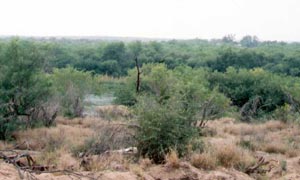Chapeño, Falcon Dam, Zapata
Another hot day beckoned and we headed north-east up route 83 to Laredo getting Harris's hawk and Northern Caracara en route. First stop was Chapeņo, a feeder site next to the Rio Grande where a local kept bird tables to attract birds and birders.
There are three main target birds to get here and we began excellently with one of them in the form of a huge female Ringed Kingfisher sitting on a nearby post - a very impressive bird. Great-tailed Grackles and Red-winged Blackbirds were, of course, abundant, feeding on the tables and we soon added a male Bullock's Oriole to the list as it flew past. Two Altamira Orioles got people going for a minute but we soon realised they weren't what we were after. Laughing Gulls, White Pelicans, Neotropic Cormorants, two Double-crested Cormorants and a 'Mexican' Duck flew up or down the river and a couple of Gull-billed Terns fished nearby.
New birds for this site kept coming with White-tipped Dove, a male Northern Cardinal, four Great Egrets, Green Jay and Brown-crested Flycatcher. Plain Chachalacas could be heard calling from the Mexican side of the river and Bank and Barn Swallows flew east following the river's course. To view area best we had to leave the 'scopes a little behind us creating what looked like a display for an optics shop.

Chapeño, looking across the Rio Grande towards Mexico
The next target bird then put in an appearance in the form of two adult and a juvenile Brown Jay. All three showed well and the yellow in the bill of the juvenile was seen clearly.
There was still one local speciality to get yet and panic struck when Pete (Peter Basterfield - ace gent.) came over the CB with the news that he, up the hill where no-one else was, had an Audubon's Oriole in his 'scope and that we wouldn't be able to see it from where we were! Tripod and 'scope in hand I charged up the hill, led only by Trevor and we both scambled for a view through Pete's 'scope. Jill and Helen arrived next but the bird had flown – not a good situation for Trevor and me! After a few minutes of depression another Audubon's Oriole was located, then another, so all had good views. Having now assured our lives were to go on for a bit longer we headed for Falcon Dam.
Falcon Dam dams the Rio Grande and the best birding is to be had downstream of the dam. As we drove to this area we picked up a Greater Roadrunner and the usual Turkey Vultures.
The car park was very hot (it got over 100°F later on) as we scanned downstream towards the reeds and open water.

Downstream from Falcon Dam
From this vantage we found a sitting Green Heron and soon another flew across the water, Red-winged Blackbirds, Least Grebe, a Spotted Sandpiper on the edge of the dam itself, Couch's Kingbird, Ladder-backed Woodpecker and singing Cactus Wren.
Now we began the hard march downstream in search of the very elusive Red-billed Pigeon. We saw very little on the way down except a couple of Red-tailed Hawks and a Bullock's Oriole. We finally reached an area where the shrubs became trees. I looked into a group of trees and bushes and announced I had a Red-billed Pigeon in full view. Unfortunately it quickly flew but was eventually seen by most people although usually in flight. Vaughan had kept quiet another bit of specialist knowledge and suddenly we were watching a Common Pauraque flying around us and through the trees. Soon there were two Pauraques flying around us, sitting down (becoming instantly invisible) then flying again. We soon left so as not to disturb these birds too much.
The walk back yielded an excellent Red-shouldered Hawk plus singing Olive Sparrow and Bewick's Wren. As we drove out of the area a quick stop to check a bird on a wire added a male American Kestrel to the list.
Zapata was our final birding spot of the day and we wanted only one bird - White-collared Seedeater. On arrival we found, contrary to most other places we had been, there was too much water to take the usual path so we had to walk around the other side. After a hot and windy (but quite short) walk we heard a song which was unfamiliar to Pete or myself. As we looked quizically at each other Vaughan came on the CB to say he'd just had a female seedeater. Back we tramped only to find it had flown. We wanted to go back to our mystery singer and when we did we soon found an in-the-open singing male White-collared Seedeater.

